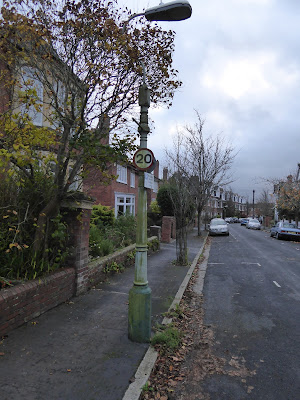The street light outside my house
... was replaced a few years ago, because the council decided that it was not economic to repair its predecessor. However, this means that along our road, we have street lights of differing ages and differing styles. (In an idle moment I wondered whether the makers of the lights have regular fashion shows to publicise their new designs; engineers marching along a catwalk carrying a light to show off to well-healed buyers!)
So I wondered about the maintenance of street lights. For instance, why are there so few hinged lamp standards? The few around here are all by footpaths, not easily accessible to scissor lifts and cherry pickers. Ladders are generally ruled out these days for health and safety reasons. Obviously the maintenance and inspection staff have fleets of lifts and pickers; increasing the number of hinged lamps standards so they were used by the roadside would lead to a reduction in the size of the fleets. A search online led to an engineering company who make a hinge that can be retro-fitted to lamp standards, and their tests on the strength of the hinge showed that the lamp standard would buckle before the hinge broke. They claimed that the payback period for their installation was less than a year. Maybe installers hesitate for two reasons: first, that if there was an accident where the upper part of the standard fell on a motorist or pedestrian, it would make headlines; second, if a vandal or mischief-maker obtained the correct key for releasing the hinge, it could lead to havoc.
More online searches led to ideas which we used to teach undergraduates as general principles for modelling of inspection and maintenance. So why do it? To ensure that the lighting systems are safe, operate correctly, continue to provide the designed performance and to maximise their life. The specifications reminded readers that maintenance can be divided into two aspects:
1. Cyclical, a process of preventative maintenance carried out on a cyclical basis to help reduce or eliminate failures and to ensure the system is operating at its intended design outputs.
2. Reactive, where failures of equipment are recorded and the equipment repaired or replaced.
And about the decision about what kind of lighting system to buy, it is clearly a multi-criteria decision problem:
"All the equipment should be selected, installed, maintained and operated to give a durable and efficient performance. Each item should be assessed for:"
And an objective is suggested: Initial cost is important but it is whole life costs (manufacturing + procurement + maintenance + energy + recycling/disposal) that should guide the final selection of equipment.
A softish constraint can be added: there are advantages in limiting the range of equipment types. Lower stock levels, availability of spares, management of repairs and experience in fault finding/repairs are all benefits that can be expected to accrue.
I still don't know what the optimal balance would be between hinged lamp standards and those without hinges (I nearly wrote "unhinged" but that suggests madness), but I can see that ideas from Operational Research have been included in the guidelines for engineers.
My thanks to the Code of Practice for Highway Lighting Management and the makers of the York Hinge for ideas from their websites.
So I wondered about the maintenance of street lights. For instance, why are there so few hinged lamp standards? The few around here are all by footpaths, not easily accessible to scissor lifts and cherry pickers. Ladders are generally ruled out these days for health and safety reasons. Obviously the maintenance and inspection staff have fleets of lifts and pickers; increasing the number of hinged lamps standards so they were used by the roadside would lead to a reduction in the size of the fleets. A search online led to an engineering company who make a hinge that can be retro-fitted to lamp standards, and their tests on the strength of the hinge showed that the lamp standard would buckle before the hinge broke. They claimed that the payback period for their installation was less than a year. Maybe installers hesitate for two reasons: first, that if there was an accident where the upper part of the standard fell on a motorist or pedestrian, it would make headlines; second, if a vandal or mischief-maker obtained the correct key for releasing the hinge, it could lead to havoc.
| A new housing estate in Exeter with the latest design in lamp standards. |
1. Cyclical, a process of preventative maintenance carried out on a cyclical basis to help reduce or eliminate failures and to ensure the system is operating at its intended design outputs.
2. Reactive, where failures of equipment are recorded and the equipment repaired or replaced.
And about the decision about what kind of lighting system to buy, it is clearly a multi-criteria decision problem:
"All the equipment should be selected, installed, maintained and operated to give a durable and efficient performance. Each item should be assessed for:"
- potential life,
- availability,
- cost of spares and replacements,
- ease of maintenance,
- recycling/disposal
- compatibility with other components.
And an objective is suggested: Initial cost is important but it is whole life costs (manufacturing + procurement + maintenance + energy + recycling/disposal) that should guide the final selection of equipment.
A softish constraint can be added: there are advantages in limiting the range of equipment types. Lower stock levels, availability of spares, management of repairs and experience in fault finding/repairs are all benefits that can be expected to accrue.
I still don't know what the optimal balance would be between hinged lamp standards and those without hinges (I nearly wrote "unhinged" but that suggests madness), but I can see that ideas from Operational Research have been included in the guidelines for engineers.
My thanks to the Code of Practice for Highway Lighting Management and the makers of the York Hinge for ideas from their websites.



Comments
Post a Comment